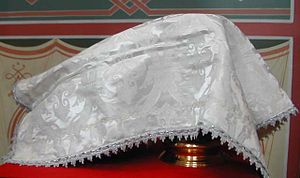Aër

The Aër (
It takes its name either from the lightness of the material of which it is made, or from the fact that during the
The Aër is first mentioned by name in an explanation of the Divine Liturgy by a writer of the sixth century, and is also alluded to as "the so-called Aër" in the Acts of the Council of Constantinople.
Divine Liturgy
At the Divine Liturgy, during the Liturgy of Preparation, when the Aër is to be placed over the Gifts (the Bread and Wine for the Eucharist), it is first wrapped around the censer and then laid over the Chalice and Diskos, so that the front edge of the Aër just touches the surface of the table. When not covering the Gifts, the Aër is folded (usually folded 3 x 3, so that when it is laid out flat the creases will form a cross). The Aër normally has a cross embroidered in its exact center,[1] so that when it is folded the cross is visible.

At the
Just before the chanting of the
Following
Other uses

During a Liturgy of Presanctified Gifts, the priest or deacon wears the Aër on his left shoulder for the Great Entrance.
Whenever a bishop first arrives at a church or monastery, he will be greeted by the senior priest holding a tray covered by an Aër, on which is placed a blessing cross for him to kiss.
At the
During
At the death of a priest or bishop, when his body is
In some of the monasteries on the Holy Mountain, when the Ecclesiarch (Sacristan) and Paraecclesiarch (his assistant) cense, each will wear an Aër on his left shoulder.
See also
Notes
- ^ Not with the cross toward the front edge, as in the Latin liturgical rites.
- Sarum Use.
External links
Articles
- OrthodoxWiki - Aer
- Aër Article from Catholic Encyclopedia
Photos
- At the Prothesis—the Aër is in the foreground with the Asterisk resting on top of it
- Before the Symbol of the Faith—priest kissing the Chalice and Diskos through the Aër
- Lifting the Aër during the Symbol of the Faith (concelebration with three priests)
- Hierarchical Liturgy—two bishops bowing under the Aër as it is held by priests
- Ordination of a priest—bearing the Aër at the Great Entrance
![]() This article incorporates text from a publication now in the public domain: Shipman, Andrew Jackson (1907). "Aër". In Herbermann, Charles (ed.). Catholic Encyclopedia. Vol. 1. New York: Robert Appleton Company.
This article incorporates text from a publication now in the public domain: Shipman, Andrew Jackson (1907). "Aër". In Herbermann, Charles (ed.). Catholic Encyclopedia. Vol. 1. New York: Robert Appleton Company.
